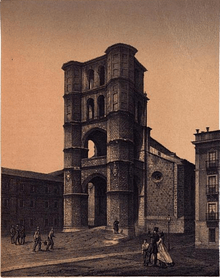San Benito el Real, Valladolid

The Church of the Monastery of San Benito el Real is a parish church and former Benedictine monastery located in the city of Valladolid, in Castile and León, Spain.
History
It was erected at the site of the old Royal Alcázar of Valladolid and designed originally in Gothic style; although the façade, with its gate-tower shape, was designed in 1569 in a Renaissance-influenced style by Rodrigo Gil de Hontañón. Originally, the towers flanking the entrance were considerably taller, but these were shortened in the 19th century due to concerns about their structural integrity.

.jpg)

The church was built using stone from 1499 to 1515, following plans of Juan de Arandia and García de Olave. It is organized by three naves, which end in three polygonal apses without a crossing. The aisles are tall, with minimal height difference with the center nave, creating a space that suggests a single church-hall, more common in the first half of 16th century.
The interior is lit through large oculi, that it open in the wall of the lateral nave of the side of the Epistle and in the apses. Originally, there were also some holes in the central nave, covered following the lifting of the rooftops towards 1580. In the section of the feet is the high choir, covering the three naves of the church.
The exterior of the building has thick walls of limestone (extracted from quarries near Valladolid, like Villanubla, Zaratán or Campaspero) and large windows that illuminate the spacious interior. The side facades are articulated by buttresses that counteract the thrust of the vaults with terceletes with which it is covered on the inside. The pillars that divide the naves are baquetonates. It can be seen that the closer sections to the head have decorated capitals and cornices, which disappears in the sections of the feet, more austere. This may be due to the search for a cheaper budget as advanced the works, begun by the head, to the medieval custom.
Interior decoration
Given that the Benedictines had then much power and being this its main house in Castile, the church held artworks of high quality.

Among the treasures that were in the church include its Altarpiece and its choir stalls, which was in the central nave.
The choir stalls (1528) were sculpted by Andres de Nájera. It has low and high chairs and was available in the central nave. The stalls were used for the annual meetings of the Benedictine abbots of the Castilian monasteries, which took place in this church. The backs of high chairs depict the saints to whom different Spanish Benedictine houses were dedicated, allowing each abbot to find their seat. The style of the stalls is Plateresque. The style to the Roman from Italy had only recently arrived to Spain. Appear decorations that are based on paintings of the Rome's Domus Aurea. The images of saints have also completely depart from prior Gothic models.
In 1571 was put the iron grille covering the three naves settled and divided transversely the church into two parts: the church's front for common people, and the apse, intended for monks. The fence is work by Tomás Celma and is an estimable sample of fencery at the time.
In addition to the altar and choir stalls were in the church other works of art of great value: small altars, tombs, organs, and others.
After the Ecclesiastical Confiscation of Mendizábal in 1835, the monastery became in fort and barracks, and the church deconsecrated. It was stripped of its works of art, though the choir stalls were kept, and the altarpiece transferred to the Museo Nacional de Escultura in the Colegio de San Gregorio, Valladolid. The fence however remains and not suffered damage. From mid-19th-century, many people called for the church's reopening; which occurred in 1892, under the Venerable Third Order of the Carmel's administration. Since 1897 it is Order of the Barefoot Carmelite which takes care of the church. In 1922 was installed a Baroque altarpiece to replace the former, from a church of the town of Portillo, Castile and León.
Adjacent to the church is the monastic building with three cloisters; one of them the known as Patio Herreriano, now a museum of contemporary art, and a Mannerist main facade designed by Juan Ribero de Rada.
In the present, the prior of the convent is Juan Jesús Sánchez Sánchez, from Convento de Padres Carmelitas in Medina del Campo.
Remain elements preserved in Museo Nacional de Escultura. Valladolid
Of the former altarpiece that had the monastery, much of the pieces composing it are now located in the Museo Nacional de Escultura in Valladolid, the rest is lost destroyed by the Confiscation. The altarpiece was made by Alonso Berruguete between 1526 and 1532.
 A relief of the altarpiece
A relief of the altarpiece
Bibliography
- María del Rosario Olivera Arranz (2002). "Valladolid". Encyclopedia of the Romanesque in Castile and León: Valladolid. Aguilar de Campoo: Fundación Santa María la Real - Centro de Estudios del Románico. pp. 433–438. ISBN 978-84-89483-22-4. 1nFDEol8FO4C&pg=PA433.
External links
| Wikimedia Commons has media related to Monastery of San Benito el Real, Valladolid. |
- monestirs.cat. "Monasterio de San Benito el Real de Valladolid".
- Valladolid Web. "Iglesia de San Benito el Real".
Coordinates: 41°39′15″N 4°43′46″W / 41.6542°N 4.7294°W